There could be one trillion different species on Earth, new study claims
There could be far more species on Earth than we thought

Your support helps us to tell the story
This election is still a dead heat, according to most polls. In a fight with such wafer-thin margins, we need reporters on the ground talking to the people Trump and Harris are courting. Your support allows us to keep sending journalists to the story.
The Independent is trusted by 27 million Americans from across the entire political spectrum every month. Unlike many other quality news outlets, we choose not to lock you out of our reporting and analysis with paywalls. But quality journalism must still be paid for.
Help us keep bring these critical stories to light. Your support makes all the difference.
A new study has claimed that Earth could be home to almost 1 trillion different species - and only one-thousandth of a percent of them have been identified.
The figure was estimated by Indiana University Bloomington resarchers Jay Lennon and Kenneth Locey, whose paper has now been published in the Proceedings of the National Academy of Sciences journal.
Using huge sets of data about known microbes, plants and animals from a variety of sources, the scientists managed to scale up the number of already-discovered species to cover the entire Earth.
Their estimate may be more accurate than previous efforts, since it takes into account the huge numbers of microorganisms which were either overlooked or ignored in earlier studies.
As Lennon says: "Older estimates were based on efforts that dramatically under-sampled the diversity of microorganisms." By taking a more kinds of microbial life into account, their estimate ended up much larger.
In total, the databases they considered for their study included 20,376 different samples of microorganisms, and 14,862 of trees and animals. They take in over 5.6 million known species, and were built from samples gathered in 35,000 locations across the globe.
The pair applied complex statistical models to their figures, feeding in the plain number of known organisms to predict the total number of species. Such models have been known to accurately predict species numbers in localised areas in the past.
As Locey said: "Until now, we haven't known whether aspects of biodiversity scale with something as simple as the abundance of organisms."
"As it turns out, the relationships are not only simple but powerful, resulting in our estimate of upwards of one trillion species."
Their discovery leaves scientists with their work cut out for them. Estimating the total number of species has traditionally been a difficult task for science, and the figures have varied significantly.
By anyone's estimate, however, there remains a huge number of undiscovered species waiting to be classified.
Join our commenting forum
Join thought-provoking conversations, follow other Independent readers and see their replies
Comments